Resources & FAQs
Helpful resources
Emergency response
Tree trimming
Renewable and energy efficiency programs
PSE offers programs to help customers reduce their environmental impact, use energy efficiently and save money. Click the link below to learn more and enroll.
Program Spotlight
Here's a look at our current program enrollment on Bainbridge Island (as of Summer 2025):
- 735 customers in PSE Flex
- 1,610 customers in Green Power
- 269 customers in Solar Choice
- 117 customers in Community Solar
FAQs
Click or tap on the topics below to view frequently asked questions.
Power 101
Reliability and outage response
There are two fundamental ways to improve reliability:
- The first is to eliminate the cause of the outage. On Bainbridge Island, trees causes most power outages. To help prevent these types of outages, we complete routine tree trimming along our facilities every year and install tree wire so power lines can better withstand falling tree branches. We have also undergrounded over half of the Island’s distribution lines.
- The second is to create redundancy in the electric system. The new Murden Cove – Winslow 115 kV transmission line will create a “loop” between the Murden Cove and Winslow substations, so each substation will be connected to two transmission lines. If one line goes out, the other line can still feed the substation and provide power to customers.
PSE’s hybrid solution for Bainbridge Island includes projects to improve transmission reliability. These projects are intended to work together to make the Island’s electric grid more resilient and reduce the impact of outages by adding redundancy to the system:
In addition, PSE has completed and is actively working on a number of other projects to improve electric service reliability on Bainbridge Island. They include but are not limited to:
- Trimming and removing trees that could come in contact with power lines.
- Replacing aging poles, wires and equipment.
- Installing tree wire in areas that see many tree-related power outages.
- Tree wire is a type of specially-coated power line that’s designed to prevent electric shorts from fallen tree limbs. This added protection can significantly reduce the frequency of branch-related outages.
- Installing electrical switches and other equipment that provide for greater operational flexibility in the event of an outage.
- Converting existing overhead lines underground to avoid tree-related power outages or hazards in higher wildfire risk areas.
See a full list of our current projects and our completed projects.
Reliable energy for our customers is one of PSE’s top priorities. There are a few challenges unique to Bainbridge Island that increase the likelihood of outages:
- Geography: Being an island is one of the biggest challenges to electric reliability because there is no neighboring infrastructure to serve as back-up.
- Trees: The combination of high winds, winter storms and tall trees mean trees are the #1 cause of outages on the Island. Bainbridge Island transmission lines are heavily exposed to trees, and 64% of outages are caused by trees.
- Learn how PSE works to prevent outages through our tree trimming program.
- Radial transmission lines: Nearly two-thirds of Bainbridge Island customers are at risk of a prolonged outage. This is because their area is served by a substation – either Winslow Substation or Murden Cove Substation – that’s fed by a single transmission line with no back-up.
- Customers served by the Winslow Substation have the worst reliability on the Island followed by customers served by the Murden Cove Substation.
- Nearly 70% of transmission customer minutes of service interruption were from the Winslow Tap transmission line that feeds the Winslow Substation.
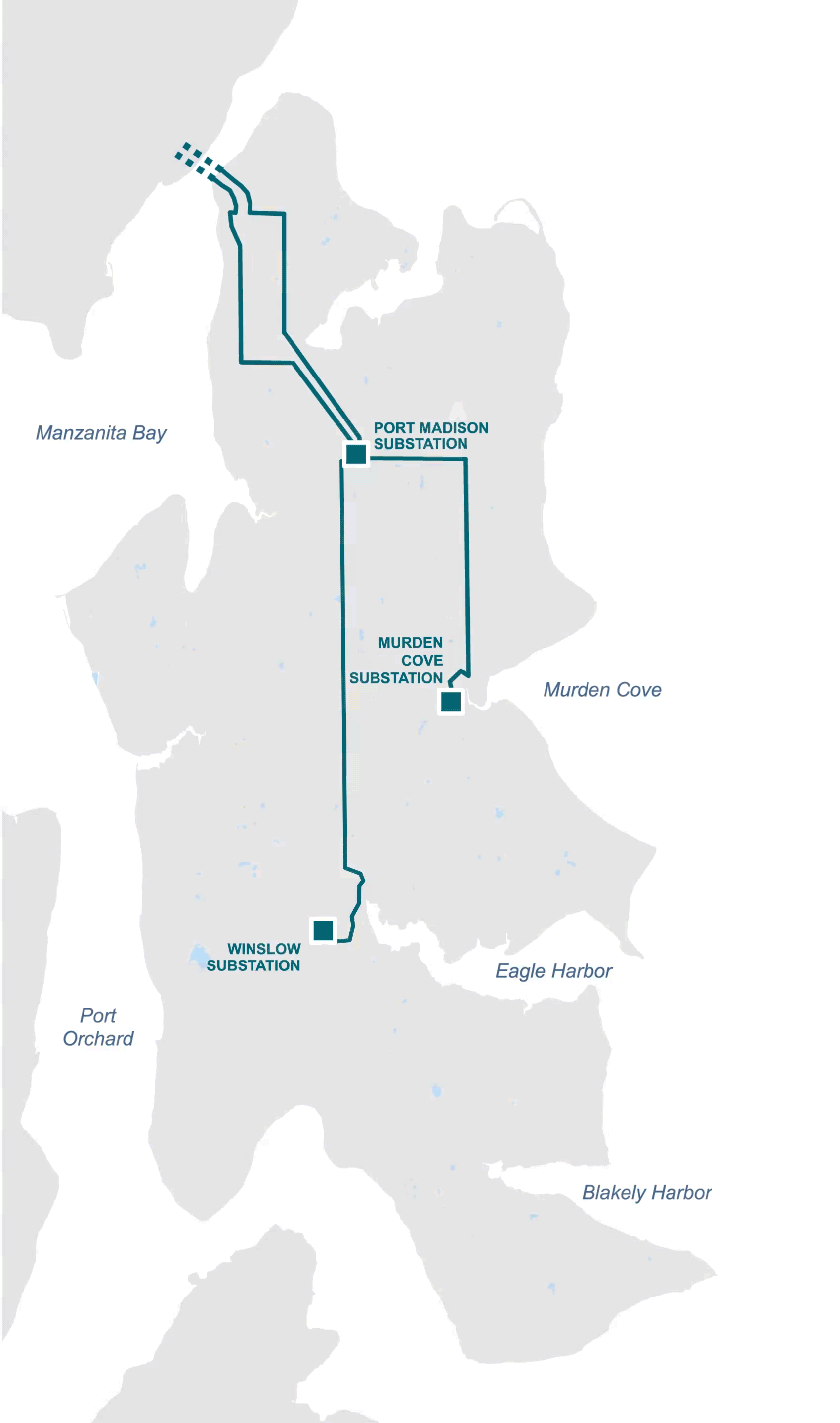
Between 2018 and 2024, Bainbridge Island experienced two island-wide outages during storm conditions. These outages occurred when trees fell on power lines that serve the island from across Agate Pass. During this same time, the Winslow Substation had 11 outages and the Murden Cove Substation had two outages. In addition, the Winslow Tap experienced 11 sustained outages (longer than a minute), and the Murden Cove Tap had one sustained outage.
In comparison to other places in PSE’s service area, Bainbridge Island experiences more outages. On Bainbridge Island, the customers along the Winslow Tap experience the most outages. This trend is consistent during the last 10 years.
Some of these outages could have been avoided if the new Murden Cove – Winslow 115 kV transmission line were in place. This line will connect the Murden Cove and Winslow substations, so each substation will be connected to two lines. If one line goes out, the other line can still feed the substation and provide power to customers. Learn more about the Murden Cove – Winslow 115 kV transmission line project.
PSE’s approach to restoring power during region-wide, local and Public Safety Power Shutoff (PSPS) outages can be found on our How power gets restored webpage.
If your power goes out, PSE will send you notification(s) to let you know your power is out and the estimated time of restoration. You can also check our outage map for the most up-to-date information about an outage.
Undergrounding Power Lines
Yes, we can underground lower-voltage distribution lines. However, there is cost sharing involved.
Our state regulators determine how underground lines are funded. The basic principle is cost sharing. If undergrounding is needed for technical reasons (e.g., not enough physical room to build an overhead line safely), then PSE pays for the undergrounding of the power lines and spreads the project costs over all 1.1 million customers. This helps keep costs low for all of our customers. On Bainbridge Island, around 56 percent (~177 miles) of distribution lines are already undergrounded. We also typically underground lines in new developments because the City of Bainbridge Island requires it and costs are shared by the developer.
If a jurisdiction or community wants to underground an existing overhead distribution line then there are cost sharing mechanisms in place through the Schedule 74 tariff. For example, if the City of Bainbridge Island wants lines undergrounded as part of a public improvement project, the cost is split 60/40 – PSE pays 60 percent of the costs and the local jurisdiction pays 40 percent plus trenching and restoration.
For more information, see our undergrounding distribution lines factsheet.
On an engineering basis, PSE can build transmission lines underground, but there are a variety of constraints (e.g., location of other utilities underground) that may limit whether undergrounding is practicable or feasible. Additionally — and as importantly — it is up to the community to decide whether to invest in it. Under PSE’s Electric Tariff G Schedule 80, PSE must first consider building overhead transmission lines because of their combination of reliability and affordability, both of which are important to our customers.
When a new line is constructed overhead, project costs are distributed evenly between PSE’s 1.2 million customers. Undergrounding is an option, but under these regulations, underground transmission lines are considered a “local option” and the local community must pay the cost difference between overhead and underground lines. Most communities decide not to invest in undergrounding transmission lines because they have other investment priorities.
For more information, see our undergrounding transmission lines factsheet.
About PSE
System ownership, regulations and rates
PSE is a heavily regulated investor-owned utility whose actions are carefully monitored and reviewed by the UTC. In order to build needed upgrades to the electrical system, we invest the money upfront. Once these capital upgrades are “live” (power is flowing through the lines and customers are receiving power from those lines), we then submit the amount of the capital investment to the UTC. The UTC reviews the investments for prudency before these amounts can impact rates. All of PSE’s work must pass muster.
Once the costs of upgrades or additions to our electrical infrastructure are approved by the UTC, they are shared by all of PSE’s 1.2 million customers and paid for over time.
PSE will combine new grid infrastructure and energy efficiency programs to improve transmission reliability and address distribution capacity.
See the map of the Bainbridge Island hybrid solution projects below and visit the Hybrid Solution webpage to learn more. This map shows where the transmission line and substation projects are located. All Bainbridge Island customers can participate in our Flex Smart+ and energy efficiency programs.
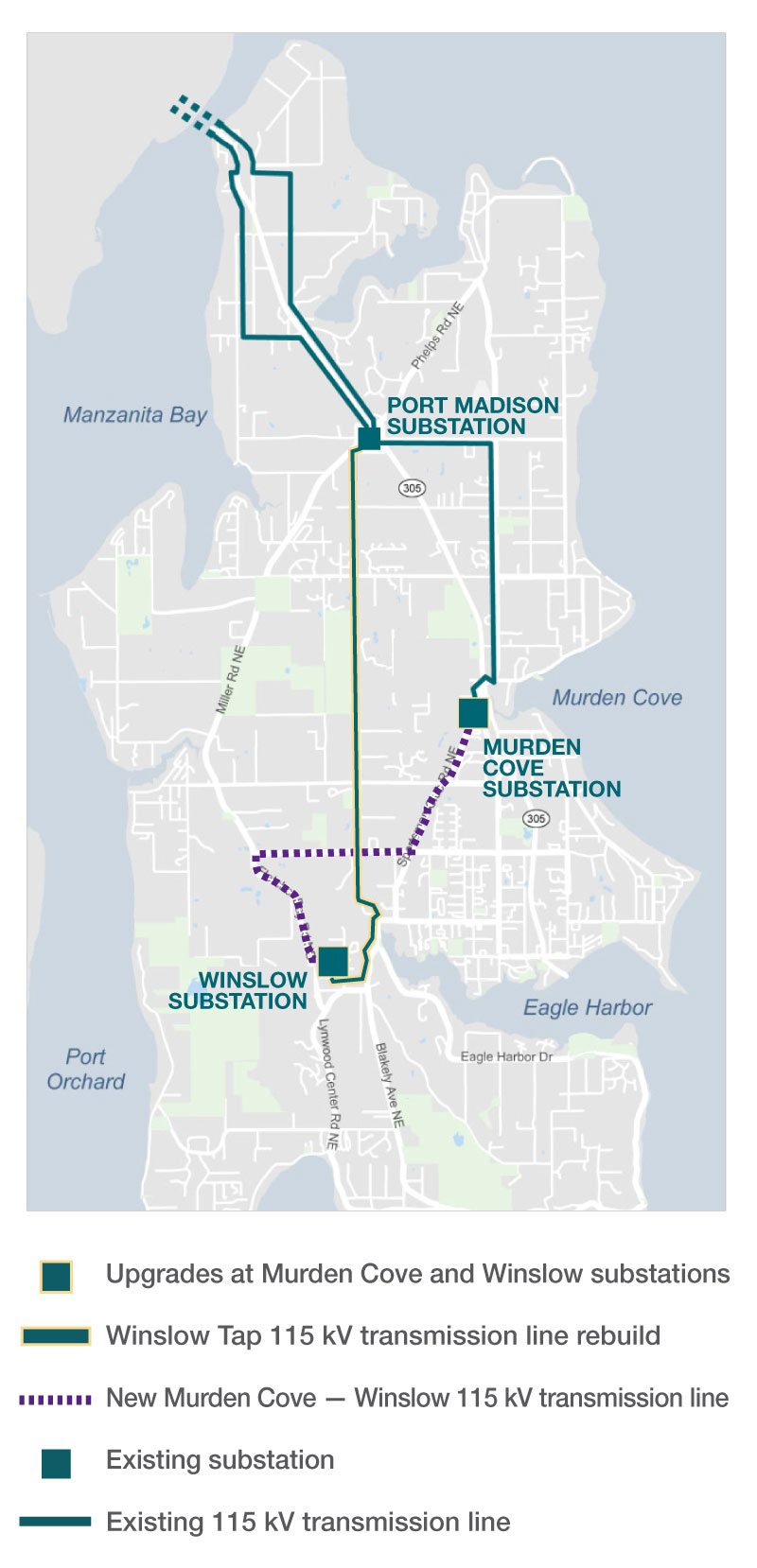
Poor transmission reliability
- Bainbridge Island customers experience more power outages and for longer durations than many of our customers. This is because two-thirds of the Island is served by either the Winslow Substation or Murden Cove Substation. These substations are fed by a single transmission line with no back-up.
Aging infrastructure
- The Winslow Tap 115 kV transmission line was built in the 1960s. Some of its poles and equipment are nearing the end of their life and need to be replaced. In addition, the line is in a heavily-vegetated corridor with difficult terrain and protected wetlands and streams, which makes outage response challenging. The Winslow Tap is the only transmission line serving the Winslow Substation, which supplies power to 4,500 homes and businesses on the south end of the Island.
Growth
- The Island’s population has grown significantly since the 1950s and increasingly relies on electricity to power their daily lives. In addition, Washington State Ferries is transitioning to a hybrid electric ferry system to reduce greenhouse gas emissions.
- Even with energy conservation, the Island needs more energy, especially during the coldest and hottest times of the year.
Learn more about Bainbridge Island’s need and solution.
Yes, there’s enough electric capacity coming onto the Island. Around ten years ago, PSE rebuilt and increased the electric capacity of the two transmission lines that carry power across Agate Pass to Port Madison Substation on Bainbridge Island. At the time, the lines were reaching their capacity limit.
With the increased capacity, these two transmission lines can reliably supply power to Bainbridge Island, even during times of high power usage or during an unplanned outage on another nearby transmission line.
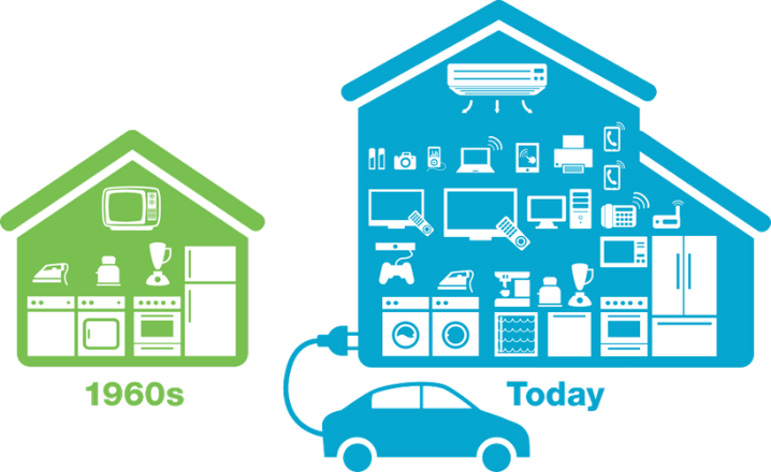
Yes, demand for energy is growing on Bainbridge Island. Here’s why:
- Population growth: Since the 1950s, the Island’s population has grown from just under 1,000 residents to nearly 25,000.
- Increased electrification:
- We increasingly rely on electricity to power our daily lives (as shown in the graphic above and chart below).
- In addition, Washington State Ferries is transitioning to a hybrid electric ferry system. This will require additional power for the Bainbridge Island ferry terminal.
Even with energy conservation, the Island needs more energy, especially during the coldest and hottest times of the year.
Learn more about Bainbridge Island’s need and solution.
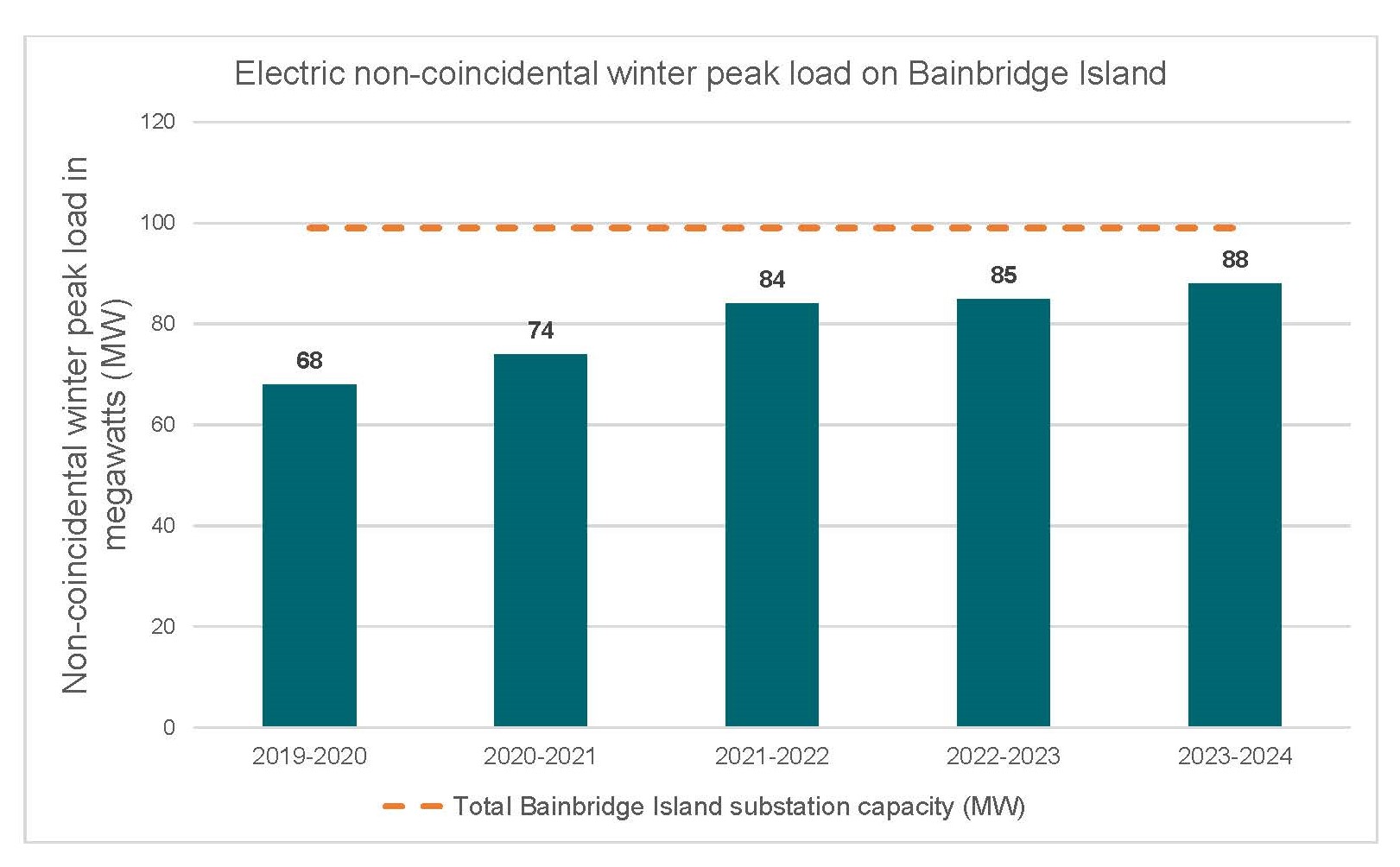
Conservation is key to helping PSE meet the Island’s energy capacity needs. In our hybrid solution, we propose 3.3 MW* of the Island’s capacity need come from distributed energy resources (DERs) such as conservation** and demand response*** programs like Flex Smart+ (This is equivalent to unplugging 22,000 refrigerators!). We anticipate that Bainbridge Island customers will continue to partner with us to meet this goal.
However, the Island’s demand for energy is growing far faster than conservation efforts can keep up with. In addition, conservation only helps in reducing capacity need. It does not address reliability.
* To meet this capacity goal, enough Bainbridge Island customers must participate in PSE’s conservation and demand response programs. If there’s not enough participation and we don’t meet our 3.3 MW goal, PSE may need to add more infrastructure to support the Island’s capacity needs.
**Conservation is lowering your energy use year-round.
***Demand response is reducing energy demand during peak periods.
PSE independent experts conducted studies to consider wires, non-wires and hybrid alternatives to identify the best solution to meet the Bainbridge Island electric system’s needs. Based on their recommendations, PSE developed a hybrid solution (a combination of wires and non-wires upgrades) for Bainbridge Island.
As part of the solution, we initially proposed to install a 3.3 MW battery energy storage system (BESS) paired with 3.3 MW of distributed energy resources (DERs)* to meet the Island’s distribution capacity needs until 2027.
Since developing this solution in 2019, we have continued to review and analyze new information. Based on this analysis, we have further refined our initial proposal to best meet the energy needs of the community. Specifically, we plan to install a second transformer within the existing Murden Cove Substation instead of a BESS to provide more electric capacity to meet all of our customers’ energy needs. PSE has always anticipated the need for a second transformer; however, due changes in our load growth and ferry electrification assumptions, we are installing the second transformer earlier than anticipated.
DERs are still a component of the hybrid solution. We continue to encourage Bainbridge Island residents to help reduce their energy use by participating in our demand response program, Flex Smart+.
*DERs are customer-sided resources such as conservation and demand response programs like Flex Smart+.
In early 2024, we reviewed the data, assumptions and technical requirements for meeting Bainbridge Island’s distribution capacity needs. Our assumptions used to create our solution in 2019 have changed, including our assumptions regarding load growth and ferry electrification.
We plan to install a second transformer within the existing Murden Cove Substation instead of a BESS to provide more electric capacity to meet all of our customers’ energy needs. PSE has always anticipated the need for a second transformer; however, due the changes in our load growth and ferry electrification assumptions, we are installing the second transformer earlier than anticipated. The BESS would not provide enough capacity quickly enough to meet the Island’s needs by 2027 based on current data and assumptions.
PSE is committed to engaging with the community on our work to improve Bainbridge Island’s electric system.
In 2019, we hosted a community meeting to announce our hybrid solution for Bainbridge Island and began engaging the community around siting the new Murden Cove – Winslow 115 kV transmission line. Through a Community Sounding Board, online community workshops, information sessions, an interactive route explorer tool and comment portal, mailings and more, we shared information about the hybrid solution projects and asked for the community’s input on selecting the route for the new transmission line. Read more about this process under the Community engagement section on the Murden Cove – Winslow 115 kV transmission line project webpage.
In 2021, after over two and half years of public engagement, we selected a final route for the Murden Cove – Winslow 115 kV transmission line. Since that time, PSE and our contractors have been completing a variety of field surveys to inform project design and permit documentation for all of the hybrid solution projects.
PSE will continue to keep the community informed of our progress on these projects, construction impacts and additional opportunities to engage. Sign-up for our monthly e-newsletter to stay up-to-date.
PSE plans to submit permits for our remaining projects according to the following schedule.
- Winslow Tap 115 kV transmission rebuild: 2026
- Murden Cove – Winslow 115 kV transmission line project: 2027
- Winslow Substation upgrades: 2027
The City will inform the community of opportunities for involvement during each permit review process.
We will keep property owners and the community informed of our progress on these projects, construction impacts and additional opportunities to engage.
Ways to stay involved:
- Sign up for our monthly e-newsletter and learn more about these projects.
- Follow us on Facebook at facebook.com/pseonbainbridgeisland.
- If you have questions, please call 1-360-394-2676 or email Bainbridge@PSE.com.
Over the past several years, PSE worked with the City of Bainbridge Island to identify and request code amendments to ensure we can continue to provide reliable electric service to Bainbridge Island residents and businesses. In September 2024, the Bainbridge Island City Council approved the code amendments. PSE is now working on updating our project permit documentation to reflect the newly adopted codes.
We have begun rights acquisition for the Winslow Tap 115 kV transmission rebuild project and expect to begin rights acquisition for the new Murden Cove – Winslow 115 kV transmission line in fall 2025. PSE must obtain all necessary easement rights before we can submit permit applications and begin construction on these projects.
At this time, we expect to submit permits for the remaining projects according to this schedule:
- Winslow Tap 115 kV transmission rebuild: 2026
- Murden Cove – Winslow 115 kV transmission line project: 2027
- Winslow Substation upgrades: 2027
Much of PSE’s existing electrical infrastructure on Bainbridge Island was built in the 1950s and 60s, when the Island was part of rural unincorporated Kitsap County. Since then, the Island’s population has grown, resulting in a greater demand for electricity, and the regulatory environment in which PSE installs, maintains and upgrades electrical infrastructure has become more complex and, in some cases, regulations prevent PSE from the installation, maintenance or upgrade of our electrical infrastructure on Bainbridge Island.
Over the past several years, PSE has worked with the City to identify and request code amendments to ensure we can continue to provide reliable electric service to Bainbridge Island residents and businesses.
In September 2024, the Bainbridge Island City Council approved the code amendments. PSE is now working on updating our project permit documentation to reflect the newly adopted codes.
PSE plans to construct the transmission lines on Bainbridge Island with primarily round wood transmission poles that are typically 60 to 75 feet above ground. The poles and their vertical configuration will be similar to other 115 kV transmission lines already on the Island. In wetlands and shoreline, PSE plans to install non-treated poles such as fiberglass or steel.
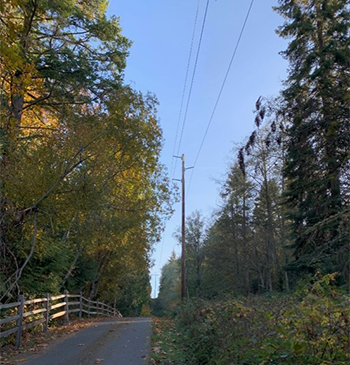
Existing 115kV lines on Bainbridge Island; not representations of future lines
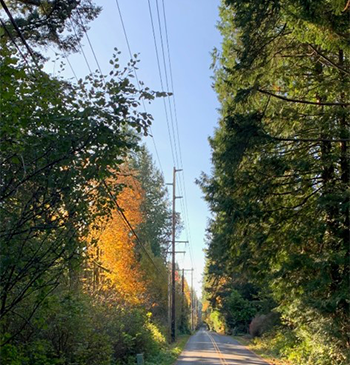
Existing 115kV lines on Bainbridge Island; not representations of future lines
For the Winslow 115 kV Tap transmission line rebuild, PSE plans to replace poles in the same general location as the existing poles, in most cases. Less than half of the existing poles along the transmission line corridor are identified to be replaced.
For the new Murden Cove – Winslow 115 kV transmission line, PSE plans to collocate the transmission line with existing aerial distribution lines on new transmission line poles (the photo above on the right shows an example of this). This means the new transmission line and existing distribution lines will be placed on the same pole. New transmission line poles will replace approximately every other existing distribution pole. The distribution poles between the transmission poles (called “skip poles”) will remain in place or be replaced themselves.
Transmission lines bring power to the substations from the generation source and distribution lines distribute the power from the substations to homes and businesses.
It’s too early to know what construction staging and impacts will look like for the Winslow Tap 115 kV transmission line rebuild and Murden Cove – Winslow 115 kV transmission line project. Once we have final designs for each of these transmission line projects, we will be able to share specific details about construction. We will continue to keep the community informed of our progress.
At a high-level, here’s our typical transmission line construction process:
- Pre-construction field surveying
- Site preparation and access (including vegetation trimming and removal)
- Installing the new transmission poles and removing the old ones
- Stringing the transmission line conductors (wires)
- Cleaning up, restoring and replanting vegetation
During construction, work on individual properties will take place in phases. The construction team may visit your property for up to a few days at a time over several weeks or months before construction is complete. As we approach construction, we will meet with affected property owners to discuss construction plans. We will also work with property owners to minimize construction impacts.
Below is our current schedule for the Flex Smart+ program and construction on our infrastructure projects. This schedule could change, depending on the progress of permitting and construction.
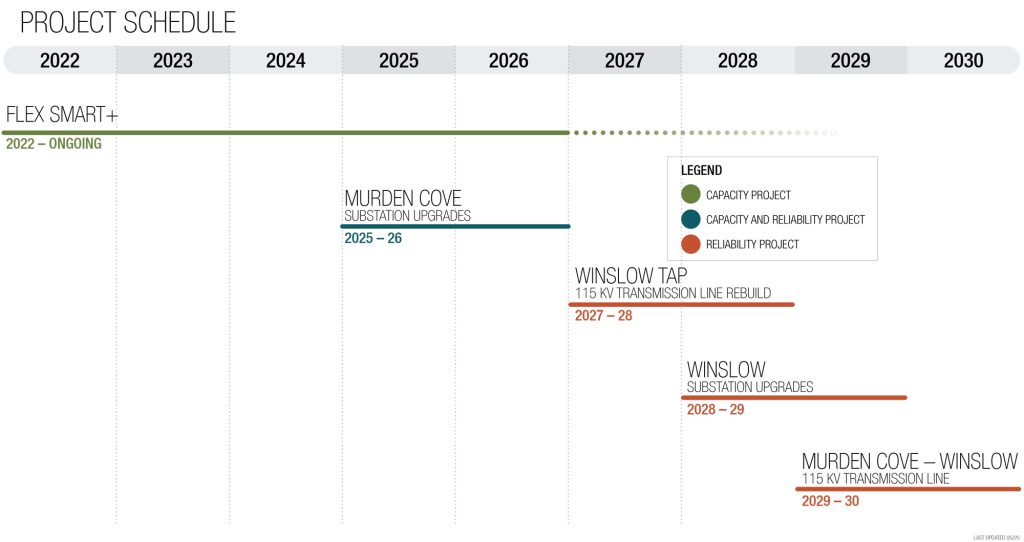
PSE approaches every project, from the smallest electrical service installation to the largest transmission line, with the same priority: the safety of our customers, the communities we work in and our fellow co-workers.
PSE employs industry best practices and follows all federal, state and local safety regulations to ensure safe design, construction and operation of our facilities on Bainbridge Island.
Electrical infrastructure is held to federal, state and local safety regulations administered by:
- Federal Energy Regulatory Commission (FERC)
- North American Electric Reliability Corporation (NERC)
- National Electrical Safety Code (NESC)
- Washington State Utility and Transportation Commission (WUTC)
- Local codes and standards
Electric and magnetic fields, or EMF, are found wherever there is electricity – in household wiring, electrical appliances, computers or power lines.
At PSE, safety is always our top priority. We rely on the findings of reputable, national and international scientific and public health organizations and agencies that have reviewed the research on EMF. Over the past 45 years, there have been many scientific studies conducted to determine if EMF has any effect on human health. To date, extensive reviews and research conducted by leading public health agencies – such as the World Health Organization (WHO) and the U.S. National Cancer Institute (NCI) (one of the U.S. National Institutes of Health) – have not established that power frequency EMF cause any adverse effects in humans or animals.
We understand that local residents may still wish to learn more. For more details about EMF studies, exposure limits and PSE’s approach to EMF, visit pse.com/pages/electromagnetic-fields